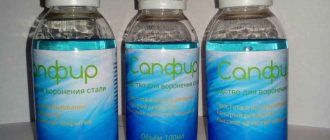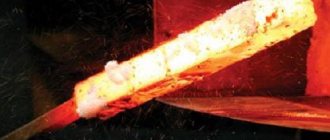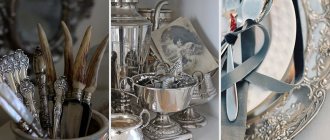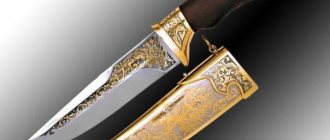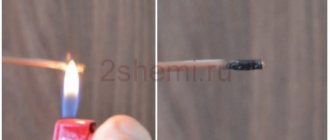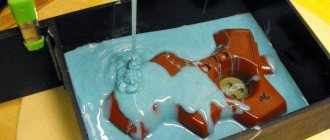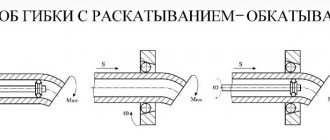Steel bluing is increasingly used for painting metal products. It provides reliable surface protection from rust and a decorative finish. With the chemical dyeing option, a protective shell appears on the surface. Oils and acids are used during the work process. Depending on the type of material used and the degree of heating, metal compounds acquire a natural shade.
Many people believe that this processing option is used only in factory conditions. But you can organize it yourself if you follow the sequence of actions and use suitable means.
Burnishing steel using linseed oil, machine oil or hemp oil
In the last article we talked about how to blue a gun barrel using “rusty varnish” and what you need to prepare the composition for blueing.
In this article we will introduce the reader to how to burnish steel using linseed oil, machine oil or hemp oil. Different shades of black appear when barrels and weapon parts are blued with different oils, more on this below. Burnishing steel using linseed oil, machine oil or hemp oil
When bluing, a steel product is heated to a high temperature and smeared with a special liquid. The sequence may vary. 1. Heat the product and dip it into the liquid. 2. Heat the product and smear it with a swab dipped in liquid 3. First, lubricate the product with liquid, and then put it in the oven and heat it to 250-300 degrees. For a denser coating, this can be done several times. I personally blued using options 1 and 2, but have never tried the third.
What is used as a bluing fluid. In the classic version, it is linseed oil or linseed or hemp oil. There is no fundamental difference. Flaxseed oil is obtained by prolonged heating - cooking linseed oil. This oil contains many unsaturated organic acids, due to which it oxidizes and polymerizes in air - “dries out.” Synthetic drying oil - oxol - should not be taken for these purposes.
Another fluid option is machine oil. Any mineral oil is suitable: I20, M8 motor oil, etc. You can take machine tool testing I-20. With semi-synthetic and synthetic oils, the result may not be the same; you need to check each specific oil.
The color and shade of bluing are not fundamentally different when using drying oil or mineral oil. But the properties of the coating are different. When heated, mineral oil impregnates the surface of the iron oxide layer, becomes charred, coked, and that’s it. Drying oil, in addition to charring on the surface of the steel, “dries out” due to oxidation by air and gives a denser coating that holds better and better protects against corrosion.
When I blued using the 1st method, to obtain a black color, I heated the steel product in a muffle to a temperature when the metal begins to glow barely noticeably in the dark. If the surface is matte (for example, stripped with a brush or coarse sandpaper), then you can heat it a little higher. If the surface is polished, then with higher heating a thicker layer of scale is formed, which then falls off in places (in spots). Also, if the product is polished before bluing, it must be thoroughly wiped and not touched with bare hands. Otherwise, your fingerprints will be clearly visible on the bluing.
After dipping into the liquid, wait a while, not long (depending on the thickness of the metal) and remove the still hot object. If you used mineral oil, carefully wipe off the remaining oil with paper rags; hot oil is easier to wipe off. If you used drying oil, use a cloth to remove any drops and smudges and leave the drying oil to dry. Hot drying oil will dry faster.
If heated below the glow-in-the-dark temperature, the bluing will have different colors (depending on the temperature). But I haven’t really experimented with this.
Large products are difficult to heat entirely and dip into liquid (especially if it is expensive drying oil). In this case, you can (according to the second option) heat it in parts with a blowtorch, gas and smear it with a swab dipped in drying oil or oil. You need to smear without smudges, because... the drops will boil and the surface will be uneven. True, these drops can be cleaned off. With this method, drying oil gives better results than mineral oil.
Source
Blackening
We will present another option on how to burnish steel with your own hands. This option is as simple as possible to use. It is suitable even for those who live in an apartment or simply do not want to carry out such a procedure with heating an alkaline or acidic liquid composition. This is bluing with a brush. Special products are sold, for example, the domestic “Raven 3” or the foreign “Prague Oxide”.
The technology is very simple to apply - you first need to remove the top fatty layer, that is, degrease the surface. But there are some disadvantages:
- It is difficult to provide a good film in areas where access is difficult. Therefore, it is better to immerse crafts with complex configurations completely in containers.
- The layer is not very durable and is not resistant to mechanical damage.
How to blacken metal at home - do-it-yourself steel bluing
Blackening (bluing) of steel not only protects it from rust, but makes it look more presentable. You can blacken weapons and other metal products at home using cold bluing or a solution of citric acid; we will look at how to blacken metal with oil with your own hands.
How to blue metal? You can do the bluing yourself using available materials. In this case you will need:
- Acetone.
- Clean rags.
- Machine oil.
- Pliers.
- Burner.
- Thick gloves, welding suit and safety glasses.
- Fire extinguisher (just in case of fire).
- A metal or glass container (that you don’t mind ruining).
- Open space sufficient for work.
Oxidation with citric acid
Blackening with citric acid protects against corrosion, oxide films and rust. This is an old method suitable for steel with a high carbon content. If you oxidize a knife in this way, then in the places where it will be sharpened, all the coating will come off. It is not too durable, suitable for items that are rarely used.
For this you will need:
- a pack of citric acid;
- hot water (90-95 degrees);
- machine oil.
Pour the entire sachet of citric acid (20 g) into a stainless steel or glass container, add hot water (about 200 g) and stir thoroughly. Dip the product into the prepared mixture and leave for 50 minutes. After some time, the beginning of the reaction can be observed. Bubbles will begin to actively form around the part. They can prevent air from reaching the product, so you can periodically (every 10-15 minutes) move the knife so that they disappear from the surface.
After 50 minutes, you can remove the part; it will turn black at the end of the process. It needs to be rinsed, oiled and wiped.
Popular methods for bluing steel at home
Steel bluing is increasingly used for painting metal products. It provides reliable surface protection from rust and a decorative finish. With the chemical dyeing option, a protective shell appears on the surface. Oils and acids are used during the work process. Depending on the type of material used and the degree of heating, metal compounds acquire a natural shade.
Many people believe that this processing option is used only in factory conditions. But you can organize it yourself if you follow the sequence of actions and use suitable means.
What can you achieve with bluing?
As a result of this work, a film of iron oxide will appear on the surface. The dimensions of its thickness completely depend on the technology used. It can be 1-10 micrometers. Using the metal bluing method, you can solve the following problems:
- protect the coating from corrosion, since rust does not appear on blued surfaces;
- give the product a more presentable appearance.
You can obtain the required coverage in many ways. But the most popular of them are alkaline, thermal or acid bluing. Alkaline treatment is ideal for DIY work. To do this you will need water, a digital scale, sodium nitrate and sodium hydroxide. You will also need a protective mask and gloves for personal safety.
For work, use only stainless steel utensils. Steel bluing is carried out under a certain temperature regime. The solution is kept in a boiling state, which is why you need to work with it extremely carefully.
To create a durable steel coating at home, the process lasts at least 1.5 hours. Before starting blackening, the surface must be degreased with a solvent. The color of the protective film is determined by the heating time, as a result of which it will constantly change. To avoid strong differences in shades, the surface is completely immersed in the solution.
Important! After completion of processing, metal products must be thoroughly washed in a soapy solution.
Burnishing: a method that has been used to protect steel from corrosion for more than 200 years
Burnishing or blackening is the process of oxidizing the surface of steel.
The structure of such a coating is microcrystalline and microporous, and the thickness ranges from 1 to 10 microns. Often, to add shine and improve anti-corrosion characteristics, the bluing layer is impregnated with neutral oil.
In the modern meaning of the word, “blueing” has been known since the 19th century and was used to reduce the corrosion of weapon steel. The classic method was to transform red-brown rust into iron scale by boiling the part in water. In the 20th century, alkaline and hot bluing methods were developed, allowing significant time savings. To date, this is still the most popular method, but has largely lost its practical significance.
Increasingly, bluing is used for decorative finishing of metals, while modern high-alloy (mainly chrome-plated, stainless) steels do not require protective oxidation. A typical example of this phenomenon can be considered certain models of knives made of P12 high-speed steel with blued blades.
Popular bluing methods
Blueing technology includes several methods, the main ones being the following:
- Alkaline method. In this case, you will have to work with oxidizing agents at a temperature of 130-150 degrees. Thanks to alkaline oxidation, iron is oxidized. But you should not work with this method in a house or apartment, as an unpleasant odor is released during the work.
- Acid method. In this case, the work is performed in acidic solutions using a chemical or electrochemical method. It is important to place the item in the solution for the specified time and act in accordance with the instructions.
- Thermal method. This type of bluing is considered the oldest and simplest in existence. This technology involves heating steel in the open air. The procedure continues until the top layer of metal reacts chemically with oxygen. The higher the heat, the darker the part will become.
Safety precautions and preparation for bluing
If you look at the root, then bluing is a common chemical reaction. And for the same reason, certain rules should be followed and the action should be carried out in a designated and equipped safe place.
Ventilation must be excellent, since caustic fumes from chemicals can easily harm the respiratory tract. All containers are allowed only from glass, porcelain or earthenware. It is mandatory to unload the weapon and dismantle the wooden parts.
Whatever bluing method is chosen, the following auxiliary materials will be needed:
- Latex gloves;
- Steel wool;
- Sandpaper of various grain sizes;
- Cleaner;
- Protective glasses;
- Powdered pumice;
- Fine sand;
- Gun oil for cleaning and lubrication;
- Cotton pads and swabs, rags, a pair of toothpicks, a shoe brush (new) and a toothbrush.
Application of rust varnish
This bluing agent is often used to obtain a smooth and even surface. It contains steel shavings, but they can be replaced with cast iron shavings. In this case, financial investments will be minimal. In this case, the workpiece must be placed in a chemical agent. The result is red or black iron oxide. This instruction, as a means for cold bluing, gives a long-lasting and effective result.
To get rid of red deposits, use a brush with fairly stiff metal bristles. As a result, only black oxide remains.
First, the metal is machined and degreased. Then the product is placed in a special composition. The bluing agent is prepared in a porcelain container. It is important to wear gloves to protect your skin. The composition is made using hydrochloric acid. It is poured in a small amount into a container. It is mixed with metal filings, nitric acid and iron rust.
Using machine oil
Knife bluing can be done at home with oil. You will need the following:
- 500 ml machine oil;
- equipment for holding the part, such as special hooks, pliers or pliers;
- metal container for bluing in oil;
- rags or paper napkins;
- gas burner, hair dryer or gas stove.
How to do the procedure if you have a hair dryer? To do this, the part is laid out on a non-combustible surface, such as a brick. Then the hair dryer is set to high heat. The part is heated as much as possible. Then, using pincers or pliers, it is placed in the bath, completely covering the surface with oil. This will ensure an even color upon completion of the procedure. Then the part is placed on a paper napkin to absorb the oil.
When processing metal using this method, you can use linseed oil. The procedure stops as soon as the desired color is obtained. The process must be repeated 3 or 4 times. At the end of each cycle, the product becomes darker.
If you are deciding how to blue your steel, this method will not turn it black. And the surface will not be too durable. This bluing product is suitable if you need to protect a steel product from rust.
Steel blueing
Hot bluing most often helps achieve a blue color. This happens when heated for a longer time. Initially, the surface acquires white, yellow, purple shades, and the result is a beautiful blue color.
Recipe 1
Burnishing steel at home using this method requires the presence of a forge, ideally with automatic blowing. Birch charcoal should be placed in a metal box, leaving room for the metal that needs to be processed.
This structure is placed in a preheated forge. The metal is smeared with vinegar, wiped and placed in a box when the coal begins to smolder. If a bluish color appears, the part must be pulled out, cooled a little and returned to its place. Such manipulations should be done 3-4 times until the correct shade is obtained.
Recipe 2
This method of obtaining blue color is carried out without heat treatment. You will need 3 grams of hexacyanoferrate (“red salt” popularly) and iron sesquichloride. For safety reasons, chemical components must be added to water, but not vice versa.
These substances are highly soluble and are strong oxidizing agents. Add them separately to 0.5 liters of water, stir and mix into one substance. We dip the steel into the resulting solution until it acquires the desired color.
Recommendations
Are you wondering how to bury metal objects yourself? To do this, you can use one of the methods that suits you. Using professional advice, you will get the perfect color of the metal, and the process itself will be carried out in a way that is safe for you.
Cold bluing involves the use of a bath or special container. But it cannot be made of any material. A wooden bath or galvanized container is optimal.
It would be good if the container was additionally equipped with hangers-hooks for placing parts in the solution. These elements can be made in the form of curved racks or mounted on a wall. Everything is determined by the height of the sides of the container and the dimensions of the workpiece.
To blue the steel, the container must be properly degreased. The best solution for this is an organic-based solvent. This can be acetone, perchlorethylene or B-70 gasoline. The base remains inert towards these compounds. But for each type of metal it is necessary to select the optimal solution. Only with its help can you obtain the optimal color and maximize the characteristics of the product.
Even if you are doing cold bluing, the work should be done outdoors or in a room with good ventilation. This is due to harmful fumes and a strong chemical odor.
If you cannot clean the surface well with a brush or abrasive, use etching. Each type of metal has its own remedy. If you have a ferrous metal product, the bluing liquid includes 100 grams of nitric, 50 grams of sulfuric and 150 grams of hydrochloric acids per 1 liter of distilled water. The surface is treated for at least 2.5 hours. Chemical polishing is used to give a smooth surface.
Thus, you can do the bluing of a steel object yourself. To do this, it is important to choose the most suitable processing method and adhere to a clear sequence of actions. As a result, you will get a corrosion-resistant surface in a suitable shade.
Basic processing rules
Blueing is essentially a chemical treatment of metal surfaces, in which not only the blackening is removed, but also a protective layer is applied.
These works are classified as hazardous, and therefore must be performed in compliance with certain rules and under special conditions.
Since the solution used for bluing contains chemically active substances with acid, special containers must be used for it.
Video:
In addition, such processing of metal surfaces also involves mechanical work, which means it is necessary to have on hand appropriate means to protect the eyes and skin.
You should also perform metal processing in a room that is equipped with a ventilation system or has a powerful exhaust hood.
In the video posted above, you can see how such processing of metal surfaces should be carried out.
When working with acid and other chemical reagents, you should use only those containers that are made of earthenware, porcelain or glass.
It is not recommended to use containers made of metal for these purposes.
Immediately before starting bluing, you should carry out a uniform and high-quality cleaning of the surface, and also completely remove traces of dirt and grease from it.
In this case, sandpaper, powdered pumice, and fine-grained sand can be used as processing material.
Before starting all work, it is recommended to thoroughly study the properties of the reagents used, as well as the procedure.
It should be remembered that the liquid contains a variety of chemical elements that, if used incorrectly, can harm the product.
You must also ensure that the solution used does not come into contact with the skin or eyes, as this can cause serious injury or burns.
